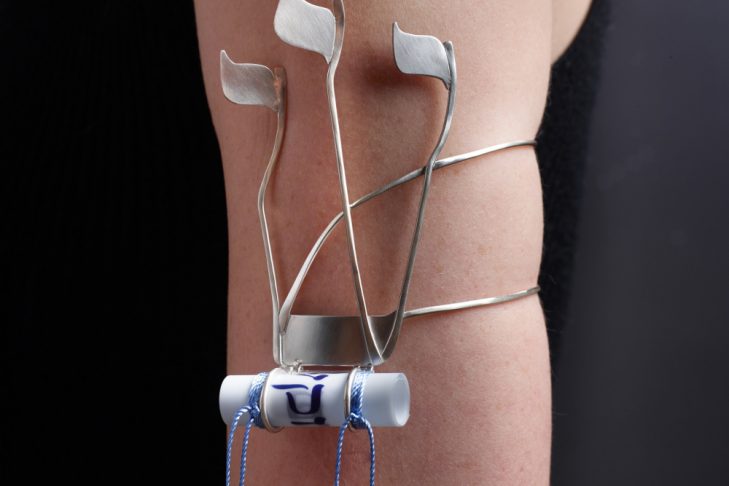D’var Torah (noun; plural: Divrei Torah): Literally “word(s) of Torah,” learnings and reflections on the weekly Torah portion (there are 54 portions).
Art d‘var: Commentary on Torah through a related work of art.
Just as Torah is a framework for Jewish life that must be unpacked and investigated from many angles to understand the depth of its content and applicability to our own lives, so is great art. This blog series illuminates works of art that help contemporize the ancient text of the Old Testament.
Tetzaveh
20th weekly portion in the Book of Exodus
5,430 Hebrew letters
1,412 Hebrew words
101 verses
It feels bashert (meant to be) as I start this Art D’var project that timing led me to Tetzaveh. Tetzaveh centers around the world’s holiest of fashion consults, between God and Moses. In great detail, God describes the clothing and anointing process of the priests (Cohanim). As a Cohenet myself, and an artist and jewelry maker with strong fashion opinions, this felt like the perfect place to delve in.
I find it amazing that in this central Jewish text, this much text is spent on discussing this level of wardrobe detail for the “kohen gadol” (high priest): “For Aaron’s ephod, take two lazuli stones and engrave in gold on them the names of the tribes of Israel. Thus Aaron shall carry their names before God as a remembrance…. In the sanctuary, says God, “Aaron shall wear a pure gold Breastplate of Judgment, with engraved stones representing the tribes of Israel. Aaron’s robe for officiating will be pure turquoise wool with bells of gold all around. In this way, the sound of the bells can be heard when the High Priest comes into the Lord’s sanctuary and when he goes out, so that he may not die. For Aaron’s forehead, you shall make a head-plate of pure gold inscribed with: ‘Holy to The Lord.’ Thus Aaron shall bring forgiveness for sins in which a sacred offering is offered” (Exodus 28, 6-13).
That’s some serious detail, down to the turquoise wool. So why does the portion spend 10% of its precious words on this?
Because this isn’t just about beauty. This is about the Torah making a statement that clothing and jewelry are core elements of culture, representing community, tradition and collective memory. These pieces that God describes are about the preservation of a physical tradition, and one that was designed to last.
When I think of the physical display of Jewish tradition in a modern context, I think of artist Tamar Paley’s conceptual jewelry. Tamar, born in Jerusalem in 1991 to American parents, has been inspired by Jewish religious text, the nature of Israel and more to lead to the many forms that her beautiful conceptual jewelry takes. One of her collections from 2017, called “A Fringe of Her Own,” a collection of ritual objects for women, specifically shows a modern look at male dress ritual objects reimagined for women.
Tamar’s work may not feature the exact lazuli stones and bells of this Torah portion, but her work is crafted with this depth of intent and attention to the meaning of the tradition. Through her beautifully crafted pieces, Paley makes both the tradition, and the innovation upon it, visible simultaneously, brilliantly featuring layers and years of tradition.
I first encountered Tamar Paley’s work in a show at the Brandeis University Kniznick Gallery, which featured “A Sign Upon Your Hand” for the first time in an American gallery. The piece was so well received that it was acquired by the Museum of Fine Arts Boston just a few months later.
The “A Sign Upon Your Hand” arm bracelet is a clear and simple yet complex example of the rules of tradition in a modern format. It’s jewelry—silver adornment for your arm. Yet it clearly reads as a “shin,” the letter that we see on the tefillin and on the mezuzah representing “shadai,” of the 100 forms of the name of God. While Tamar has reimagined the scale, the fit and the look of this completely, what she has done is focus in on the name of God, showing that in this jewelry format this piece has not lost its holiness, but rather reimagined how we call out that holiness.
Here Tamar speaks with Judy Bolton-Fasman of JewishBoston.com about the meaning behind “A Sign Upon Your Hand,” and the two other pieces acquired by the MFA.
So as we launch into this Art D’var project together, I hope this pushes you to think about the ways contemporary art and life connect to the weekly Torah portion; to go down the rabbit hole of Tamar’s thoughtful reinterpretations of tradition; to consider the role of fashion, color and visual presentation in your own life.
And if Tetzaveh leaves us with one simple thing, I believe it’s that fashion isn’t the surface issue it can often be critiqued as. Fashion is art and design that helps us keep memory alive and honor our past as we move into the future.
Until the next portion, shavua tov, have a great week.
This post has been contributed by a third party. The opinions, facts and any media content are presented solely by the author, and JewishBoston assumes no responsibility for them. Want to add your voice to the conversation? Publish your own post here. MORE



